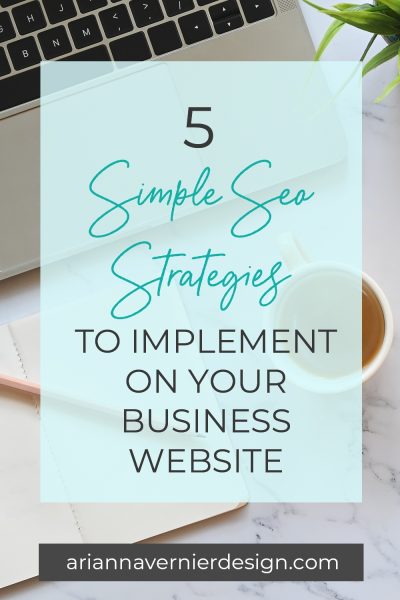
Episode 30: What Should You Include On Your About Page for Your Business Website?
In this episode of the Business Website Blueprint podcast, I’m sharing what you should include on your website about page.
Do you struggle with getting organic traffic to visit your site?
Are you wondering how to get more people to visit your website from Google, or any other search engine?
If you have a business at all, you need to be familiar with the term SEO. If you’re not already familiar with SEO, this blog post/podcast episode is for you.
In this episode of the Business Website Blueprint Podcast, I’m sharing five simple SEO strategies that you can implement on your business website, making it easier for organic traffic to find your business and for you to make more sales.
Quick Disclosure: This blog post contains affiliate links, which means when you click the link to purchase something on this page, it won’t cost you more but I may receive a commission for sharing it with you. Which is great, because I was going to share it with you anyway!

SEO stands for search engine optimization, and it basically means using keywords that your ideal client or customer would be searching. When you use those keywords, you will start to rank and get your pages on the first couple pages of the search engine.
You want to think about what terms your ideal client or customer would be searching if they’re looking for help with whatever service or product you offer.
The first of the 5 simple SEO strategies is to identify the long-tail keywords you should be using.
Short-tail keywords are just a couple of words long, and it’s a lot harder to rank for those shorter terms because there are so many other business websites using these shorter keywords.
By using long-tail keywords, it is much easier to start to rank for those keywords.
Let’s walk through an example. Say you have a business in the wedding industry. A short-tail keyword might be something like “wedding business” or “wedding photographer”. There are 2 problems with using a keyword like this:
A long-tail keyword for this example could be “wedding photographer near Detroit, Michigan.” That’s what people would probably be searching if they were looking for a photographer in that area.
If your business is location specific, you can use things like your county name, state, city, etc as part of your long-tail keywords.
When you use long-tail keywords, your dream clients or customers are more likely to find your page because you will be ranking higher for that long-tail keyword than you would for the short-tail version.
Long-tail keywords allow you to hit that sweet spot of medium volume of people searching that term and a low difficulty of actually ranking for that term.
Another benefit of using long-tail keywords is that they’re highly specific, which means that users that are searching for that term are probably looking for exactly what you have to offer. This means they’re a lot more likely to stay on your website, potentially sign up for your emails, buy your product, or complete your inquiry form.
If you need help figuring out what keywords you should be using for your website, I highly recommend the website uber suggest Ubersuggest. It’s a free keyword tool that you can use to search long-tail keywords in your industry.
Another tool you can use to search long-tail keywords is the Pinterest search bar. If you go to Pinterest and type in the first couple words of something related to your business, a whole search list will pop up. All of the statements that pop up would be considered long-tail keywords.
For example, if you type “social media” in the Pinterest search bar, a box will drop down from below the search bar and it will say things like “social media templates”, “social media strategies”, etc.
If you want to start ranking for the keywords you’re using and reach more customers and clients organically, you need to use those long-tail keywords throughout your website copy.
3 simple SEO strategies you can use throughout your copy are:
Please remember that you don’t want to just copy and paste the keyword everywhere. Google doesn’t like that, and they will penalize you if they notice that when they crawl your website. They can tell when you’re just trying hard to rank. Using different variations of your long-tail keyword is going to be your best option.
Another way to implement more SEO strategy on your website is to rename your major pages with your long-tail keywords.
If your homepage on the back end of your site is just labeled “home”, you’re not utilizing any SEO terms.
An example of using that long-tail keyword on my website would be – “Arianna Vernier – WordPress Website Designer and Developer.” This is one of the terms I want to rank for, so I used that in the title of my page rather than just having it titled “home.”
Now you don’t want that whole SEO title to be listed in your main menu on your website, so you can simply rename it to “home” in your menu settings.
So when you upload an image to your WordPress website, there is a spot to enter in alt text, description text, and a caption as well. Make sure you utilize that space and use your keywords throughout there as well!
The final simple SEO strategy kind of wraps all of the tips together, and it is to make sure that you install the Yoast Plugin on your website. They have a tutorial on their website walking you through exactly how to adjust all of the settings for your website, so make sure you follow that tutorial.
On the backend of your website pages, there is also a Yoast section where you can:
Yoast is by far the number 1 plugin I recommend to help you boost your SEO ranking for your business website.
I hope this episode helped you to start implementing more SEO strategies on your business website, so that you can start ranking more and getting more of that organic traffic.
If you’re still confused and wondering how you can improve your website SEO, I am more than happy to hop on a free call with you and talk through getting the SEO optimized on your website.
And, as a reminder, I am always offering Website VIP Days where I will get your website built for you in just a few days. There are still a few openings this coming month, so check out the details and schedule your free call with me here!
com forward slash services


In this episode of the Business Website Blueprint podcast, I’m sharing what you should include on your website about page.

In this episode of the Business Website Blueprint podcast, I’m sharing 5 tips to help you sell more products or services on your business website.

In this episode of the Business Website Blueprint podcast, I’m sharing 3 ways to build trust and authority on your business website.